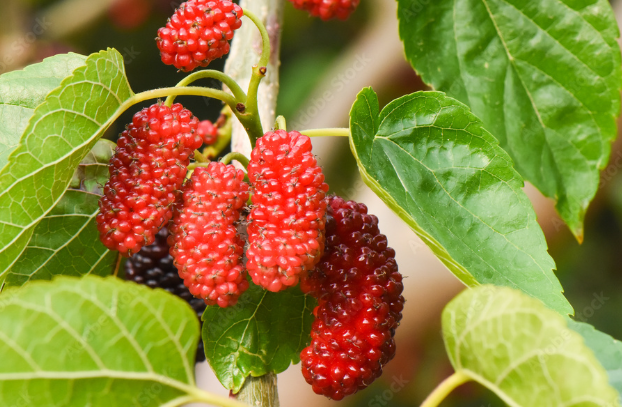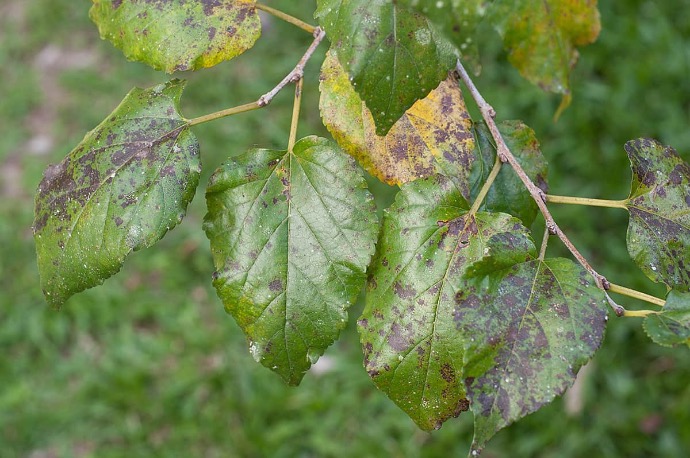Red Mulberry Tree
Red mulberry trees, 35-50 feet tall in Zones 5-9, grow rapidly in well-drained soil and full sun. Known for their sweet and edible berries, red mulberries are enjoyed fresh or in jams and desserts.

Habit
Tree
Height
4 to 6 m
Growth
Fast
Soil
Well-drained, Sandy Loam
Shade
Full Sun
Moisture
Moderate
Edible
Yes
Medicinal
Yes
Origin
North America
Climatic Condition
Temperate, Subtropical
Temperature (°)
15°C to 25°C
Humidity (%)
50% to 70%
Potting media
50% Loam, 40% Sand, 10% Organic Matter
Fertilizers
Organic Fertilizer
Watering
Regular watering
Plant Weight
5 to 10 kg
Flowering Time
Spring to Summer
Soil Ph level
6.0 to 7.0
Water Ph level
6.0 to 7.5
Soil EC
0.6 to 1.0 mS/cm
Yield Per Plant
3 to 5 kg per tree
NPK ratio
10:10:10
life Span
10 to 30 years
Health Benefits
High in Antioxidants, Medicinal
Suggested Grow Media or Potting Mix ?
50% loam, 25% compost, 25% sand
Suggested Fertigation/Fertilizers
Fertilize every 6 weeks with a balanced fertilizer.
Common Diseases and Remedies
powdery mildew , leaf spot
White powdery spots on leaves,dark brown to black spots appear on leaves
neem oil
HEALTH BENEFITS
· Supports digestion, blood sugar control, and immune function.
· Rich in resveratrol, beneficial for heart health.
What Is A Red Mulberry?
Red mulberry is a small to medium-sized deciduous tree 10 to 15 meters (35 to 50 ft) tall, rarely 21 meters (70 ft), with a trunk diameter of up to 50 centimeters (20 inches).

What Are The Different types of mulberries ?
Is a fast-growing tree that grows in valleys, floodplains, and low, moist slopes. This species reaches its greatest size in the Ohio River Basin and reaches its highest elevation (600 m or 2,000 feet) in the southern foothills of the Appalachians. Three types of mulberries are commonly eaten. White mulberry, Malva mulberry. Red Mulberry, M. rubra. and Kurosuwa, M. Nigra. (The color of the fruit has nothing to do with the species name. Many white mulberry trees have black berries.

How To care for a mulberry plant?
1. Location: -
Drainage Plant in a sunny location with good soil.
2. Sunlight: -
Mulberry trees grow in both full sun and partial shade. Like many fruit trees, they need plenty of light. The more it is, the more it helps the tree bear fruit.
3.Soil:-
Mulberry trees are moderately adaptable and can easily cope with loamy, loamy and sandy soils as long as the mixture provides adequate drainage. Trees can grow in pH ranging from neutral to slightly acidic.
4.Hydration:-
After planting, water your mulberry tree regularly and thoroughly to help it build a strong root system. We recommend using 2 to 3 gallons per week for the first year.

5. Nourishment: -
Mulberry trees can benefit from annual fertilization, but often grow very well without fertilization. Feed the tree once in late winter with a balanced 10-10-10 mixture, measuring 1 pound of fertilizer per inch of trunk diameter.
6. Issues: -
Oak root rot, bacterial leaf blight, bacterial leaf blight, canker, damp wood, wood rot, spot disease, powdery mildew, leaf rust, leaf blight. Mealybugs, leaf rollers, bihar caterpillars, wingless grasshoppers, thrips, moths, whiteflies, scale insects, stem borers, May-June beetles, termites.
What are the benefits of mulberry plants?
Helps improve eyesight, nourish the liver, repel wind and remove heat. It also helps treat dizziness and red diarrhea, supports liver function, maintains youthful skin, helps with cough and cold symptoms, strengthens the blood, treats colic, and strengthens the eyes.

FAQ's about growing mulberries
1. What is the best time to plant mulberries?
Mulberries are best planted in late fall or early spring when the soil is workable and temperatures are mild.
2.What type of soil do mulberries prefer?
Mulberries grow in well-drained soils that are slightly acidic to neutral (pH 5.5 to 7.0). They tolerate a variety of soil types, but prefer loamy soils.
3. How much sunlight do mulberry plants need?
Mulberries prefer full sun, but can also tolerate partial shade. For optimal growth and fruit production, provide at least 6 hours of direct sunlight per day.
4. How often should I water mulberries?
Water newly planted mulberry tree regularly to keep the soil evenly moist.
5. Do mulberry trees need to be pruned?
Mulberry trees benefit from annual pruning to maintain shape, remove dead or diseased branches, and encourage fruit production. I am receiving



